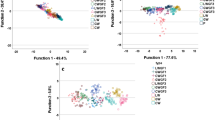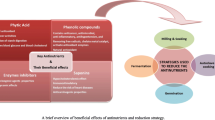Abstract
Wheat flour is used in most of breads because of its nutrient components and high availability, but different problems are associated with this flour, such as allergies and loss of nutrient components due to milling and refining. In this study, five flours were used (20 %) in combination with wheat flour (80 %).to produce traditional Iranian Barbari bread. These included amaranth, barley, DDGS, rye and oat. Compositional measurements of moisture, fat, fiber, protein and ash content were taken. Physical tests were done to understand the changes in color, thickness, and texture. Results showed that the gluten content of each flour had a significant effect on the texture and thickness of the bread. Bread made with rye flour had the highest L* and that made with oat flour had the highest a*. As for b*, the highest was for the bread made with DDGS. It was also determined that bread made with 20 % DDGS and 80 % wheat flour had the highest fiber and moisture content, while that made with amaranth had the highest ash content, and that with rye had the highest fat. Adding different flours to wheat changed the physical and chemical attributes of final producst significantly.


Similar content being viewed by others
References
American Association of Cereal Chemists (AACC). (2000) Approved methods of the American association of cereal chemists, 10th Ed. St. Paul, MN, USA
AOAC International. (2003) Method 920.39. Official methods of analysis of the association of analytical chemists, 17th edn. The Association, Gaithersburg
Ayo JA (2001) The effect of amaranth grain flour on the quality of bread. Int J Food Prop 4(2):341–351
Belgacem MN, Gandini A (2008) Monomers, polymers and composites from renewable resources. Elsevier Publications, Amsterdam
Belyea RL, Rausch KD, Tumbleson ME (2004) Composition of corn and distillers dried grains with solubles from dry grind ethanol processing. Bioresour Technol 94:293–298
Chen H, Rubenthaler GL, Leung HK, Baranowski JD (1988) Chemical, physical and baking properties of apple fiber compared with wheat and oat bran. Cereal Chem 65(3):244–247
Cromwell GL, Herkelman KL, Stahly TS (1993) Physical, chemical and nutritional characteristics of DDGS for chicks and pigs. J Anim Sci 71:679–686
Czerniejewski CP, Shank CW, Bechtel WG, Bradley WB (1964) The minerals of wheat, flour and bread. Cereal Chem 2:65–72
Esteller MS, Lannes CSS (2008) Production and characterization of sponge-dough bread using scalded rye. J Texture Stud 39:56–67
Faridi HA, Finney PL, Rubenthaler GL, Hubbard JD (1982) Functional (bread making) and compositional characteristics of Iranian flat breads. J Food Sci 47(3):926–929
Finley JW, Hanomoto MM (1980) Milling and baking properties of dried brewers’ spent grains. Cereal Chem 57:166–168
Golmohammadi A, Akram A, Omid M, Mohammad-Khani A (2005) Study of physical characteristics of flat bread made of three Iranian wheat cultivars. Int J Agric Biol 7(4):634–637
Gould JM, Jasberg BJ, Dexter LB, Hsu JT, Lewis MS, Fahey GC (1989) High-fiber, noncaloric flour substitute for baked foods, properties of alkaline peroxide-treated lignocellulose. Cereal Chem 66(3):201–205
Gujral HS, Gaur S (2005) Instrumental texture of chapathi as affected by barley flour, glycerol monostearate and sodium chloride. Int J Food Prop 8:377–385
Gujral HS, Pathak A (2002) Effect of composite flours and additives on the texture of chapathi. J Food Eng 55:173–179
Horszwald A, Troszynska A, Delcastillo D, Zielinski H (2009) Protein and sensorial properties of rye breads. Eur Food Res Technol 229:875–886
Huttner A, Arendt EK (2010) Recent advances in gluten-free baking and current status of oat. Trends Food Sci Technol 6:303–312
Marrioti M, Lucisan M, Pagani A (2006) Development of baking procedure for the production of oat-supplemented wheat bread. Int J Food Nutr 41:151–157
Mckevith B (2004) Nutritional aspects of cereals. Nutr Bull 29:111–142
Morita N, Kang WW, Hamauzu Z, Sugimoto Y (1999) Effect of amaranth flour on some properties of wheat dough and bread. Japan Soc Appl Glycosci 1:23–30
Qarooni J (1996) Flat bread technology. Chapman and Hall, New York
Rakhan A, Aman P, Andersson R (2010) Characterization of dietary fiber components in rye products. Food Chem 119:859–867
Reddy NR, Pierson MD, Cooler FW (1986) Supplementation of wheat muffins with dried distiller’s grain flour. J Food Qual 9:243–249
Sabanis D, Lebesi D, Tzia C (2009) Effect of dietary fiber enrichment on selected properties of gluten-free bread. Food Sci Technol 42:1380–1389
Saiz AI, Lurlina MO, Borla OP, Fritz R (2007) Rheological properties of dough and sensorial quality of bread made from whole meal rye-wheat blend with the addition of gluten. Ital J Food Sci 19:439–448
Sidhu JS, Kabir Y (2007) Functional foods from cereal grains. Int J Food Prop 10:231–244
Skendi A, Biliadenis CG, Papageorgiou M, Izydorczyk MS (2010) Effect of two barley β-glucan isolates on wheat flour dough and bread properties. Food Chem 119:1159–1167
Tsen CC, Eyestone W, Weber JL (1982) Evaluation of the quality of cookies supplemented with distiller’s died grains flour. J Food Sci 47:684–685
Tsen CC, Weber JL, Eyestone W (1983) Evaluation of distillers’ dried grain flour as a bread ingredient. Cereal Chem 60(4):295–297
Wu YV, Youngs VL, Warner K, Bookwalter GN (1987) Evaluation of spaghetti supplemented with corn distiller’s dried grains. Cereal Chem 64(6):434–436
Zappa G, Rolle L, Piazza L (2007) Textural characteristics of typical Italian “Grissino Stirato” and “Rubata” bread-sticks. J Food Sci 4(19):449–459
Acknowledgments
The authors would like to thank the USDA-ARS and the South Dakota Agricultural Experiment Station for funding for this project.
Author information
Authors and Affiliations
Corresponding author
Rights and permissions
About this article
Cite this article
Pourafshar, S., Rosentrater, K.A. & Krishnan, P.G. Using alternative flours as partial replacement of barbari bread formulation (traditional Iranian bread). J Food Sci Technol 52, 5691–5699 (2015). https://doi.org/10.1007/s13197-014-1640-z
Revised:
Accepted:
Published:
Issue Date:
DOI: https://doi.org/10.1007/s13197-014-1640-z




